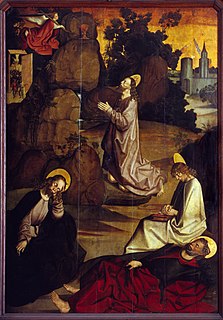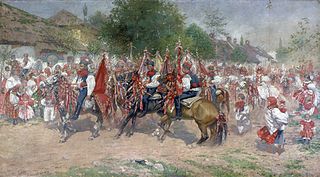 W
WThe Adoration of Our Lord from Hluboká is a panel painting dating from the period around 1380, ascribed to the Master of the Třeboň Altarpiece or his workshop. It is on display in the permanent collection of the Aleš South Bohemian Gallery in Hluboká nad Vltavou as a loan from National Heritage Institute in České Budějovice.
 W
WThe Death of the Virgin Mary of Košátky is a Bohemian panel painting from the period around 1340-1350.
 W
WThe Wrocław Holy Trinity is a Bohemian panel painting dating from the period around 1350.
 W
WThe Kaufmann Crucifixion is a Bohemian Gothic panel painting by an unknown artist that dates from 1340-1360. It was most probably the central part of a relatively small folding altarpiece.
 W
WThe Litoměřice Altarpiece (1505-1507) was a large altar retable, in all likelihood with two pairs of movable wings and two pairs of fixed ones. From these wings, six panels have survived, two of which are painted on both sides. The movable wings on the left-hand side of the altar are presumed lost. The altar wing depicting Christ on the Mount of Olives belongs to the Diocese of Litoměřice, while the other panels are owned by the Regional Museum in Litoměřice. It is the largest surviving set of panel paintings by an anonymous late Gothic and early Renaissance painter called the Master of the Litoměřice Altarpiece. The altarpiece is part of the permanent collection of the North Bohemian Gallery of Fine Art in Litoměřice.
 W
WThe panel painting of The Madonna between St Catherine and St Margaret dating from the period before 1360 most probably formed the central part of a lost altarpiece in the Cistercian Abbey of Zlatá Koruna. It is a key work of early Bohemian Gothic painting. It is on display at the permanent collection of the Aleš South Bohemian Gallery in Hluboká nad Vltavou.
 W
WThe Enthroned Madonna of Kłodzko is a Bohemian panel painting dating from 1343-1344 that was originally the central part of a larger winged altarpiece. The altarpiece's donor was Archbishop Arnošt of Pardubice, who is portrayed in the bottom left-hand corner.
 W
WThe Veveri Madonna, also called the Madonna of Veveri, is an tempera painting by the unknown moravian, bohemian artist generally called Master of Vyšší Brod. The altarpiece was commissioned after 1344 by Margrave John Henry of Luxembourg for the romanesque church of Assumption of Our Lady, In the neighborhood of royal Veveří castle in Brno, Moravia, Czech Republic. Exhibited in Diocesan Museum in Brno. The panel was one of the first Madonnas painted by the artist. Albert Kutal a Czech scholar called it "a truly rare and extraordinary work".
 W
WThe Zbraslav Madonna comes from the parish church of St James the Greater in Zbraslav. It is on long-term loan at the permanent exhibition of the National Gallery in Prague.
 W
WThe Portrait of the Gem-cutter Dionysio Miseroni and his Family is a 1653 group portrait by Czech artist Karel Škréta of an craftsman's family. This representative example of the Bohemian Baroque style is currently deposited in the Schwarzenberg Palace, a part of collection of the National Gallery in Prague, Czech Republic.
 W
WThe Ride of Kings is an 1892 painting by the Czech artist Joža Uprka.
 W
WThe Slav Epic is a cycle of 20 large canvases painted by Czech Art Nouveau painter Alfons Mucha between 1910 and 1928. The cycle depicts the mythology and history of Czechs and other Slavic peoples. In 1928, after finishing his monumental work, Mucha bestowed the cycle upon the city of Prague on condition that the city build a special pavilion for it. Prior to 2012, the work was a part of the permanent exhibition at the chateau in the town of Moravský Krumlov in the South Moravian Region of the Czech Republic. In 2012, all 20 works were moved and displayed together on the ground floor of the Veletržní Palace till 2016, in an exhibition organized by the National Gallery in Prague. The works are currently not on display, waiting for a new location to be completed in Prague.
 W
WSleepwalker, "Somnambulist" is a painting from 1925 by Czech surrealist Jindřich Štyrský.
 W
WThe St Catherine Altarpiece is a set of panel paintings from the period around 1515 that is ascribed to the workshop of the Master of the Litoměřice Altarpiece. A total of six panel paintings survive from the original retable: one wing painted on both sides and two panels painted on one side in the collection of the National Gallery in Prague and two panels in the private collection of G. Schäfer (Schweinfurt).
 W
WSt Sebastian is a 20th-century painting by the Bohemian artist Bohumil Kubišta. Saint Sebastian was a Christian martyr. It is held in the National Gallery in Prague.
 W
WThe St. Vitus Madonna comes from the treasure of St. Vitus Cathedral in Prague and is exhibited in its original frame in the permanent collection of the National Gallery in Prague.
 W
WThe Třeboň Altarpiece, also known as Wittingau altarpiece, is one of the most important works of European Gothic panel painting. Of the original large altarpiece retable created in about 1380 by an anonymous Gothic painter called the Master of the Třeboň Altarpiece, three wings, painted on both sides, have survived. The altarpiece is one of the works that helped towards the emergence of the International Gothic style and which influenced the development of art in a broad European context. It was originally created for the Augustinian Church of St Giles in Třeboň and is now part of the permanent collection of medieval art of the National Gallery in Prague.
 W
WThe Votive Panel of Jan Očko of Vlašim is a Gothic panel painting now in the National Gallery in Prague, Czech Republic. It is one of the most important artworks made in medieval Bohemia. The panel was painted for the Prague archbishop Jan Očko of Vlašim who is depicted kneeling before St. Adalbert of Prague in the lower part of the picture. The author(s) of the painting is (are) not known. The style of the painting stands between the works of Theodoric of Prague and the Master of the Třeboň Altarpiece.
 W
WThe Vyšší Brod (Hohenfurth) cycle, ranks among the most important monuments of European Gothic painting. It is made up of nine panel paintings depicting scenes from the Life of Christ, covering his childhood, Passion and resurrection. These paintings were made between 1345 and 1350 in the workshop of the Master of Vyšší Brod that was most probably based in Prague. The pictures were either meant for a square altar retable or else they decorated the choir partition of the church of the Cistercian Abbey in Vyšší Brod.
 W
W